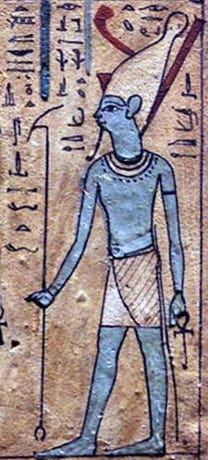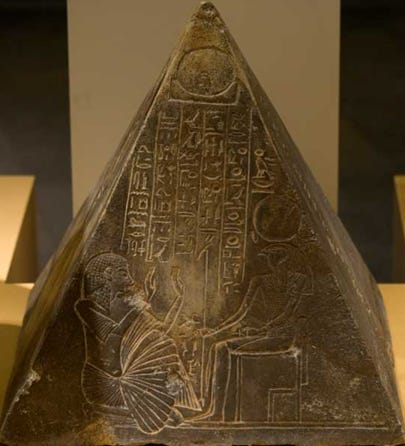Mythical Benben Stone: The Landing Site of Egyptian God Atum
The Benben stone is an object that is found in the mythology of ancient Egypt. This mythical stone is said to have once been housed in a shrine within the compounds of the temple dedicated to the deity Atum in Heliopolis. The Benben stone is also an architectural term, and is the name given to the tip of an obelisk or the capstone placed on top of a pyramid. This architectural feature is known also as a pyramidion (or pyramidia in its plural form).
In the mythology of ancient Egypt, there are several accounts of the creation of the world. One of these is centred on the god Atum, and had its origins in the city of Heliopolis. According to this version of the creation story, the universe was brought into being by Atum. In the beginning, there was nothing but darkness and chaos. It was out of the dark waters that the primordial hill, known as the Benben stone arose, on top of which stood Atum. As the Benben stone rose from the primeval waters, it has been suggested that this word is associated with the verb ‘weben’, which is the Egyptian hieroglyph for ‘to rise’.

According to another interpretation, the Benben stone was the primeval hill on which Atum first landed. The god looked around, and realised that there was nothing around him but darkness and chaos, and that he was all alone. Desiring companionship, Atum began the work of creation. In some versions of the myth, Atum masturbated, and through this act, created Shu (the god of air) and Tefnut (the goddess of moisture). In other versions of the story, these deities were created by Atum’s copulation with his own shadow. Shu and Tefnut left Atum on the Benben stone, and went away to create the rest of the world. After some time, Atum is said to have grown worried about his children. Removing his eye, he sent it in search of them. Shu and Tefnut returned with their father’s eye, and the deity, seeing his children return, shed tears of joy. These teardrops, which fell on the Benben stone that Atum was standing on, transformed into human beings.

The Benben stone is also recorded to have been a sacred object that was once kept in the special shrine known as the ‘hwt benben’, which translates as ‘House of the Benben’. This sacred relic was the innermost sanctuary of the temple in Heliopolis, where Atum once served as its chief deity. The original cult object is said to have been lost at some point of time in history. Nevertheless, based on pictorial evidence, it has been suggested that this was an upright stone with a rounded top. It has also been pointed out that later on, other solar temples would also have their own Benben stones. For example, the temple of Aten in El-Amarna / Akhetaten, that was built by the 18 th Dynasty pharaoh, Akhenaten, during the 14 th century B.C., is recorded to have possessed a Benben stone of its own.

Apart from being the name of a cult object, the Benben stone is also used to describe a type of ancient Egyptian architectural element. To the ancient Egyptians, this was known as a ‘benbenet’ (the feminine form of ‘benben’), whereas for people today, the stone is known also as a pyramidion. This term is used to describe the capstone that was placed either on the top of a pyramid or on the top of an obelisk. It has been said that in the case of the former, the pyramidion is often covered with electrum or gold. Examples of pyramidions have survived, and may be found in museums. One, for instance, is the pyramidion that once topped the 12 th Dynasty Pyramid of Amenemhat III, which is today displayed in the Egyptian museum in Cairo.

Top image: The Benben stone (pyramidion) from the Pyramid of Amenemhat III, Egyptian museum, Cairo. Source: Public domain
By Wu Mingren
References
Dollinger, A., 2011. Architectural elements. [Online]
Available at: http://www.reshafim.org.il/ad/egypt/building/elements.htm
Dunn, J., 2016. Egypt: Atum, Lord of the Two Lands, Lord of Heliopolis. [Online]
Available at: http://www.touregypt.net/featurestories/atum.htm
Kemp, B. J., 2006. Ancient Egypt: Anatomy of a Civilization. 2nd ed. London and New York: Routledge.
The Global Egyptian Museum, 2016. Benben. [Online]
Available at: http://www.globalegyptianmuseum.org/glossary.aspx?id=87
Tyldesley, J., 2010. The Penguin Book of Myths and Legends of Ancient Egypt. London: Penguin Books.



In the temples, the benben was also represented by the bier, with a mound of sand, upon which the statue of the deity was placed after being taken out from its shrine. This represented the emergence of Ra-Atum (or other Gods equated with him) from the primordial waters upon the benben to create the world.
The benben was also called Tatanen, in such cases associated with the God Ptah from Memphis.
I stongly suspect the original benben was a meteorite judging by its shape, they became cult objects in other places too (Cyprus, thr Kaaba,...)